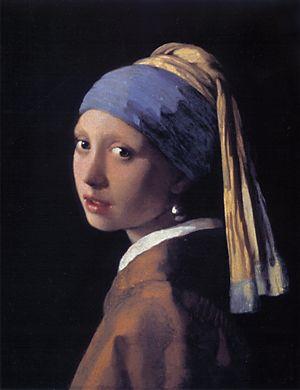| . |

Girl With a Pearl Earring
(Reviewed November 12, 2003)
-
An absolute masterpiece. As of November 12, this elegantly simple and quietly beautiful movie about a meek and dejected teenage girl who becomes the maid of painter Johannes Vermeer in 1665 is my
favorite movie of 2003.
Until I saw "Girl With a Pearl Earring" last night, that slot was held by "Lost in Translation." Scarlett Johansson stars in both movies, providing understated but utterly convincing portrayals of
sad characters briefly awakened from resigned hopelessness by older men. Although her characters in both movies share a certain melancholy, their circumstances could not be more different.
In "Lost in Translation," Johansson's
fleeting luxury-Tokyo-hotel friendship with a burned-out movie star (Bill Murray) raises her spirits while she is being ignored by her rock-star-photographer husband. She is the exact opposite of moneyed and educated in "Girl With a Pearl Earring," toiling as an illiterate bottom-rung member of Vermeer's household staff because she has to support her mother and her blind father. (Although the story is entirely fictional, its details
are so convincing that you never will look at the actual painting the same way again.)
Johansson's daily drudgery in "Girl With a Pearl Earring" is broken only by the confused feelings she has for the handsome but tight-lipped painter and for his art. Her reluctance to act upon those feelings, or even to
speak (in what is nearly a silent performance), gives the movie a tension that manages to be heartbreaking without once devolving into sappy melodrama. Even though the basic plot here
admittedly sounds like the stuff of cheap romance ("SHE INSPIRED HIM TO PAINT...WITH THE COLORS OF LOVE!"), it is played so honestly that it overcomes its time-worn genre trappings to
seem fresh and genuine. There is a reason why this kind of yearning/denial/resolution stuff has worked for a couple of millennia, after all. "Girl With a Pearl Earring" director Peter Webber finds the classic in
what so often is rendered as cloying or cliche.
This also is one of the most breathtakingly beautiful movies ever filmed, with cinematography so lush and lighting so flawlessly lovely that I wondered if John Alcott had come back from the
dead. Nearly every frame could be a page in a picture book, but the images go beyond mere prettiness. Lingering shots of Johansson's silently radiant face, of Vermeer's studio sanctuary, of
a golden canal pathway, of a candle-lit 17th-century drawing room...they are like images from dreams, full of mystery and portent. Director of Photography Eduardo Serra should win the
Oscar in a walk, if there is any justice in this world.
The movie's score was composed by Alexandre Desplat, and must be singled out for avoiding easy cliches as artfully as the plot itself does. That is not to say the music is in any way cold or
remote, however; it's the difference between cheap sentiment and emotional honesty. There are moments when the combination of image and music will make you get misty, but you won't feel as if
you've been crudely goosed or tear-jerked-off. The final shot of the movie literally made tears run down my jaded, cynical face, but it was a case of being deeply touched, not sucker-punched. (And I'm a
big enough man to admit it...sniff...)
If possible, make the effort to see this movie in a theatre. Even the biggest home-video plasma monitor cannot possibly give you the total-immersion thrill of seeing this amazingly beautiful
masterpiece on the big screen. It's the difference between admiring a framed masterwork in a museum gallery versus seeing it on a postcard in the museum gift shop.
To read more about the actual painting, here is a good website where you can start (click the link below to get there):
Girl With a Pearl Earring Website
Back Row Grade: A+
(Return to index by closing this window)
|
. |

